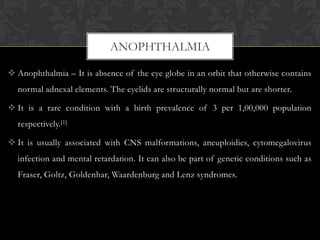Rare Eye Condition: A Guide To Bilateral Anophthalmia For Parents And Healthcare Professionals

Table of Contents
Understanding Bilateral Anophthalmia
Definition and Prevalence
Bilateral anophthalmia is a rare congenital condition defined by the complete absence of both eyes at birth. This is distinct from microphthalmia, where the eyes are present but abnormally small. The absence of eyes, also known as ocular aplasia, results from developmental abnormalities during gestation. While precise prevalence statistics are difficult to obtain due to the condition's rarity, estimates suggest it affects only a few individuals per 1 million births. The condition is often associated with significant challenges related to vision, facial development, and psychosocial well-being.
Causes and Risk Factors
The exact etiology of bilateral anophthalmia remains complex and often multifactorial. While some cases are linked to specific genetic mutations, many remain idiopathic (of unknown cause). Several factors are believed to contribute to its development. These include:
- Genetic Mutations: A variety of genetic syndromes are associated with bilateral anophthalmia, including SOX2, PAX6, and OTX2 gene mutations. These genes play crucial roles in eye development.
- Developmental Disorders: Several developmental disorders, such as anophthalmia-microphthalmia syndrome, are characterized by varying degrees of eye malformation, often including bilateral anophthalmia.
- Teratogens: Exposure to certain teratogens (environmental agents that can cause birth defects) during pregnancy, such as certain medications or infections, may increase the risk of bilateral anophthalmia.
- Prenatal Factors: Other factors impacting fetal development, such as maternal health issues or nutritional deficiencies during pregnancy, may also contribute to this condition.
Bullet Points:
- Specific genetic syndromes associated with bilateral anophthalmia include anophthalmia-microphthalmia syndrome, and those involving mutations in the PAX6, SOX2, and OTX2 genes.
- Potential environmental factors during pregnancy include exposure to certain medications (like thalidomide), infections (like rubella), and potentially certain toxins.
- Genetic counseling is crucial for affected families to understand recurrence risks and make informed decisions regarding future pregnancies.
Diagnosis and Assessment of Bilateral Anophthalmia
Prenatal Diagnosis
Detecting bilateral anophthalmia prenatally can be challenging, but advancements in imaging technology offer some possibilities.
- Prenatal Ultrasound: Ultrasound examinations during pregnancy can sometimes reveal the absence of eye structures. However, the accuracy of prenatal ultrasound in detecting bilateral anophthalmia varies.
- Fetal MRI: Fetal MRI provides more detailed imaging than ultrasound and can be used to confirm the diagnosis in suspected cases. However, this is not a routinely performed test.
Both techniques have limitations, and a definitive diagnosis often requires postnatal confirmation.
Postnatal Diagnosis
After birth, a thorough clinical examination is crucial to establish a definitive diagnosis of bilateral anophthalmia.
- Ophthalmologic Examination: A comprehensive ophthalmologic examination by an experienced ophthalmologist is necessary to confirm the absence of eye structures. This may include using specialized imaging.
- Physical Examination: A detailed physical examination helps assess the overall facial features and identify any associated anomalies, assisting in determining the possible cause or related syndromes.
- Clinical Assessment: A complete clinical assessment combines the findings from the ophthalmologic and physical examinations and often includes genetic testing to investigate possible underlying genetic causes.
Bullet Points:
- A thorough ophthalmologic examination involves detailed assessment of the orbital structures to confirm the absence of eyeballs.
- Early intervention is essential to address associated challenges and provide appropriate support.
- Imaging techniques, such as CT scans or MRI scans, can help assess orbital development and identify any associated abnormalities.
Management and Support for Individuals with Bilateral Anophthalmia
Prosthetic Options
Ocular prostheses, commonly known as artificial eyes, are frequently used to improve the cosmetic appearance and potentially enhance the fit of eyewear.
- Ocular Prosthesis: These prostheses can be custom-made to match the individual's features. Different materials and techniques are available to create a lifelike appearance.
- Orbital Implants: In some cases, orbital implants may be used to improve the shape and contour of the eye sockets before prosthesis fitting.
- Prosthetic Fitting: The timing of prosthetic fitting depends on factors like orbital development and the child's age. Early intervention is often advised.
Psychological and Social Support
The psychological and social well-being of individuals with bilateral anophthalmia and their families is paramount.
- Psychological Support: Counseling services can help families cope with the diagnosis and provide emotional support.
- Social Integration: Early intervention programs and support groups play a crucial role in facilitating social integration and building self-esteem.
- Emotional Well-being: Addressing the emotional challenges associated with the condition is crucial for both the individual and their family.
Vision Rehabilitation
While bilateral anophthalmia results in the absence of sight, vision rehabilitation focuses on maximizing other senses and providing assistive technology.
- Low Vision Aids: Although not applicable in cases of bilateral anophthalmia, this section highlights the broad approach of vision rehabilitation.
- Assistive Technology: Assistive technology, such as specialized equipment and software, can help improve daily living skills and independence.
- Sensory Integration: Developing other senses, such as hearing and touch, is crucial.
Bullet Points:
- Resources for parents include support groups, online communities, and educational materials.
- Support organizations dedicated to rare conditions can offer valuable information and connections.
- An interdisciplinary approach, involving ophthalmologists, psychologists, social workers, and other specialists, is essential for comprehensive care.
Research and Future Directions
Current research in bilateral anophthalmia focuses on several key areas:
- Research Advancements: Scientists are actively investigating the genetic basis of the condition to identify specific genes and mutations involved.
- Clinical Trials: Research is underway to explore potential treatments, including gene therapy and regenerative medicine techniques, to promote eye development.
- Gene Therapy: Gene therapy holds promise for correcting genetic defects responsible for bilateral anophthalmia.
- Regenerative Medicine: Regenerative medicine approaches aim to stimulate the growth of new eye tissues.
Further research is needed to fully understand the etiology, develop effective treatments, and improve the quality of life for individuals with bilateral anophthalmia.
Conclusion
Bilateral anophthalmia is a rare congenital condition requiring a multidisciplinary approach to care. Understanding the causes, implementing appropriate diagnostic methods, and providing comprehensive management and support are crucial for optimizing the individual's well-being. Early intervention, involving ophthalmological assessments, prosthetic fitting, psychological support, and access to support groups, are essential. Continuous research advancements provide hope for future treatments and improved quality of life. To learn more about managing bilateral anophthalmia and accessing vital resources, please explore support organizations and online communities dedicated to this rare condition. Finding the right bilateral anophthalmia resources and understanding bilateral anophthalmia can significantly impact the lives of affected individuals and their families. Seek information and support—you are not alone.

Featured Posts
-
 Astros Foundation College Classic A Showcase Of Collegiate Baseball Talent In Houston
May 12, 2025
Astros Foundation College Classic A Showcase Of Collegiate Baseball Talent In Houston
May 12, 2025 -
 Yankees Judges Dominant Start Puts Braves Slow Opening In Perspective
May 12, 2025
Yankees Judges Dominant Start Puts Braves Slow Opening In Perspective
May 12, 2025 -
 Boston Celtics Player Forgoes Nba Award Campaign
May 12, 2025
Boston Celtics Player Forgoes Nba Award Campaign
May 12, 2025 -
 Juan Sotos Post Kay Interview Surge Coincidence Or Causation
May 12, 2025
Juan Sotos Post Kay Interview Surge Coincidence Or Causation
May 12, 2025 -
 Indy Car Warm Up At Thermal Club Palou Leads Dixon
May 12, 2025
Indy Car Warm Up At Thermal Club Palou Leads Dixon
May 12, 2025
Latest Posts
-
 The Most Emotional Rocky Film Stallones Choice And Why It Matters
May 12, 2025
The Most Emotional Rocky Film Stallones Choice And Why It Matters
May 12, 2025 -
 Which Rocky Movie Touches Stallone The Most His Emotional Favorite Revealed
May 12, 2025
Which Rocky Movie Touches Stallone The Most His Emotional Favorite Revealed
May 12, 2025 -
 Rocky Franchise Stallone Reveals His Most Emotional Favorite
May 12, 2025
Rocky Franchise Stallone Reveals His Most Emotional Favorite
May 12, 2025 -
 Stallones Pick The Most Emotionally Powerful Rocky Film
May 12, 2025
Stallones Pick The Most Emotionally Powerful Rocky Film
May 12, 2025 -
 One And Done Sylvester Stallones Single Non Acting Directing Venture
May 12, 2025
One And Done Sylvester Stallones Single Non Acting Directing Venture
May 12, 2025
